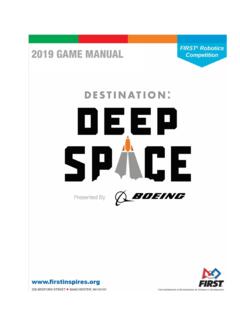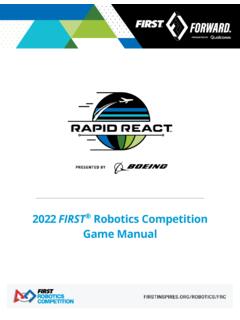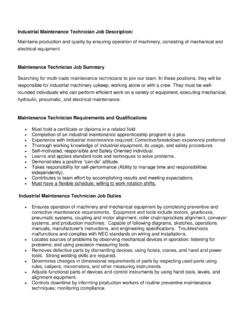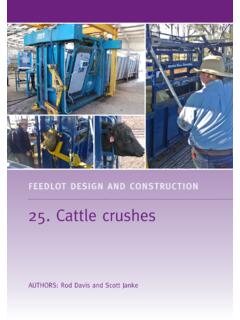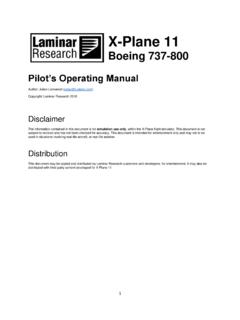Transcription of FIRST Robotics Competition Pneumatics Manual
1 FIRST Robotics Competition Pneumatics Manual The FIRST Robotics Competition (FRC) pneumatic components are outlined in this document. It is being provided as a courtesy, and therefore does not supersede any information or rules provided in the FIRST . Robotics Competition Manual . For official questions, please go to the FIRST Forums at FIRST , the FIRST logo, FIRST Robotics Competition , Coopertition , Gracious Professionalism , and Sport for the Mind are trademarks of the United States Foundation for Inspiration and Recognition of Science and Technology ( FIRST ). 2016-2017 FIRST . All rights reserved. FIRST FRC Pneumatics Manual Page 1 of 23. Contents pneumatic Advantages ..3. pneumatic Components ..4. Pneumatics Control Module ..4. Compressor ..5. Pressure Relief Valve ..5. Pressure Switch ..6. Air Tank ..6. Regulators.
2 7. Electric Valves ..7. Gauges ..8. Parker Fittings ..8. Custom Bimba Cylinders ..9. Pneumatics Setup ..10. Compressor and Relief Valve ..10. Pressure Switch, Gauge, and Plug Valve ..11. Regulator and Gauge ..12. Actuation ..12. Electrical Valve ..13. Air Tank ..13. Plumbing ..14. Wiring ..14. Setup ..15. Calibration of Relief Valve ..15. Cylinder Length Example ..17. Appendix Example On Board Setups ..18. Example Off Board Setups ..19. Appendix B ..20. Appendix C ..23. FIRST FRC Pneumatics Manual Page 2 of 23. pneumatic Advantages Fluid power technology encompasses both hydraulics and Pneumatics . hydraulic applications use pressurized fluids, mostly oil, while pneumatic applications use pressurized gases, mostly air. Mobile construction equipment uses a hydraulic pump mounted on the engine. The outlet of the pump is plumbed to a set of valves.
3 Each valve is then plumbed to a cylinder. This allows you to distribute power from the engine all around the equipment. The same is true for an FRC robot. Once you install the compressor operating one valve and cylinder combination, you've done most of the work. To add an additional valve and cylinder combination, you just tee into the pressure line, add in the additional circuit, and update your code. Weight - Compare the weight of several valves and cylinders to that of the motors, gears, belts, and chains used on some lift mechanisms and you will find the weight comparable, if not much lighter. Simple to Design - Using Pneumatics is much easier than building a motor; gear, chain and sprocket lift mechanism. Once you have reviewed the layout in Appendix A, you will find it very easy to build a circuit. Adjustable Force - To adjust the force of the cylinder, all you have to do is adjust the regulator in front of it.
4 The force is equal to the area of the cylinder piston times the pressure. Remember that the valves need a minimum of 15 30 psi to work properly. Durable - All of us have problems burning up motors from time to time. You can stall an air cylinder against a load indefinitely and turn off the compressor. The materials provided are industrial grade products. Strong - Teams have the option of using a small bore cylinder at 20psi, a medium cylinder at , or a large 2 cylinder. By varying the pressure to the cylinders, you can produce a force from 9 pounds up to 180 pounds, depending on your needs. Custom Cylinders and a Rotary Actuator - You can order the cylinder you need for the job, listed in Appendix C. Last Minute Additions - At the last minute, you can add a cylinder and valve very quickly. FIRST FRC Pneumatics Manual Page 3 of 23.
5 pneumatic Components Below are the components needed to set up an FRC Pneumatics system. Pneumatics Control Module Cross the Road Electronics' Pneumatics Control Module (PCM) is in each Rookie Kit. The PCM is used to control the compressor, solenoids, and pressure switch. The pressure switch should be wired into the 2. Weidmuller ports labeled PRESSURE SW , while the compressor's red and black wires should go directly into the red and black COMPRESSOR OUT Weidmuller connectors. The PCM can control 8 single solenoid valves or 4 double solenoid valves. It also supports both 12 and 24. volt solenoids however, only one voltage may be used at a time. This 12 or 24 volt selection is done by relocating the jumper in the VSOL slot. The solenoids provide in the Rookie Kit and via FIRST Choice is 24 volt so make sure the jumper is in the correct location before turning on.
6 Finally the PCM receives power from the PDP via the 2 Vin connectors and signal from the 4 CAN connectors. The PCM will handle turning the compressor on and off based on the state of the pressure switch and the Enable state of the robot. If any Solenoid Valve object is opened (LabVIEW) or constructed (C++/Java) in your code, the PCM compressor control will be automatically enabled. FIRST FRC Pneumatics Manual Page 4 of 23. Compressor Compressors are in each rookie team's Kickoff Kit and available through FIRST Choice for 2015. The compressor is a Viair 090C Air Compressor. It will put out approximately 120psi before the relief valve opens. Because the compressor can produce a significant amount of vibration, we recommend that you use vibration isolation mounts that come preinstalled on the compressor. In order for these to isolate the vibration, they need to be mounted to a stiff piece of material, such as a 1/4 aluminum plate.
7 The compressor can also get very hot and should not be in direct contact with anything else. The compressor should be wired directly to the COMPRESSOR OUT Weidmuller connectors on the pneumatic control module (PCM). Do not reverse the compressor! The compressor can be mounted on or off-board the robot. Please read Game & Season Manual Section 8 Robot Rules for all of the rules associated with this. Pressure Relief Valve IMI Precision Engineering (formerly known as Norgren) has supplied the 120 PSI pressure relief valve in each rookie Kickoff Kit as well as FIRST Choice. The pressure relief valve needs to be connected to compressor via hard fittings. If a team is using an off board compressor, then 2 pressure relief valves will be necessary, one on the robot and one on the compressor. It is up to the teams to properly install the relief valve as shown in the instructions below.
8 This is a safety measure meant to ensure proper operation of the pneumatic system. FIRST FRC Pneumatics Manual Page 5 of 23. Pressure Switch We have included a pressure switch manufactured by Nason in FIRST Choice and the rookie Kickoff Kit for 2015. This switch is normally closed. The switches will open at approximately 115 psi and will not close again until the pressure drops to approximately 95 psi. This will allow you to turn off the compressor once you are up to 115psi, saving power in the battery. It must be wired directly to the PRESSURE SW . Weidmuller connectors. The PCM will handle turning the compressor on and off based on the state of the pressure switch and the Enable state of the robot. If any Solenoid Valve object is opened (LabVIEW) or constructed (C++/Java) in your code, the PCM compressor control will be automatically enabled.
9 Air Tank A plastic air tank is available in FIRST Choice and the rookie Kickoff Kit from Clippard Instruments. The tank is designed to withstand up to 125 psi and temperatures from 35F to 100F. It should also be installed such that it is protected from impact to reduce the risk of rupturing. When securing the tank ensure that fasteners do not get over tightened or apply pressure to the tank. FIRST FRC Pneumatics Manual Page 6 of 23. Regulators IMI Precision Engineering has supplied the primary pressure regulator. This is a relieving regulator. This means that it will limit the downstream system pressure and can relieve excess pressure if something in the downstream system causes the pressure to increase. This regulator has a maximum output pressure of 60 psi and must be placed before any working components. The pressure is adjustable and may be reduced for use on your robot at your discretion.
10 On the top of the regulator, you will note that one port extends out a little bit more than the others and has an arrow on it. This arrow is to denote the outlet of the regulator. The opposite port is the inlet. A pressure gauge may be placed in either of the other ports if desired, and you will have to plug the other port with one of the enclosed hex plugs. Electric Valves FESTO has supplied one complete double solenoid valve kit. The packaging will contain one two way valve, two plug socket wire, and three fittings. The pictures above are similar to what you will receive in the rookie kit, except the rookie kit solenoid comes with the electrical base pre-installed. The pneumatic tube fittings are the push to connect type so all you have to do is push in the tubing and then pull back slightly to ensure a snug fit.

